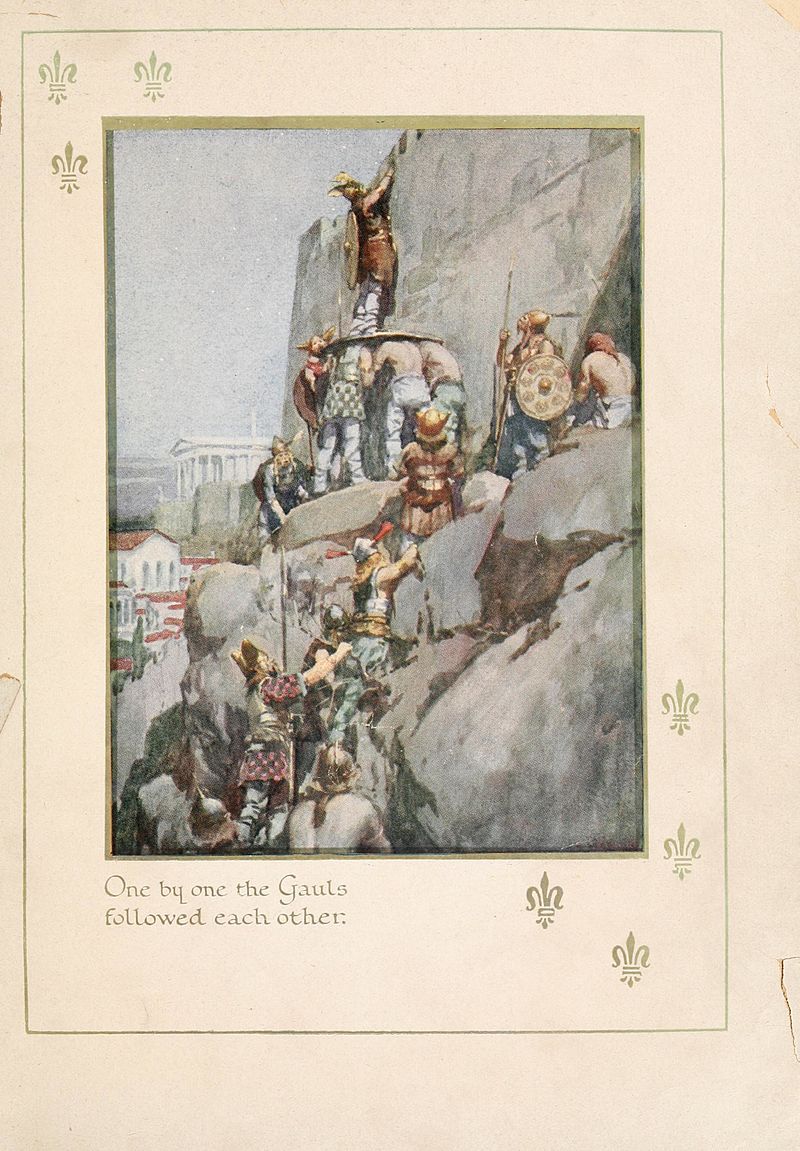Roman-Gallic Wars (225-200 BC)

The Roman-Gallic Wars were a series of conflicts between the forces of Ancient Rome and various groups identified as Gauls (or Galli, Galatai, Celts, Celtae, Keltai, Keltoi). Among these were the Senones, Insubres, Boii and Gaesatae. Broadly, the Gauls crossed the Alps from France (Transalpine Gaul) into Italy (Cisalpine Gaul) and tried to expand south through Etruria toward Rome. After centuries, Rome was victorious in Italy and took the battle across the Alps into France.
Cisalpine

Gauls attacking the City of Rome

Major conflicts on the Italian side of the Alps include:
390BC. Brennus leads the Senones to Clusium in Etruria. Rome sends an army to drive the Senones away, which they defeat at the Battle of the Allia. Three years later, Brennus leads his men to besiege Rome.
302BC. Gauls cross the Alps into Transalpine Gaul, where Gallic tribes allow them to pass southward and some join the march (as do some Etruscans). They pillage Roman territory and retire with the loot, but then fall to fighting among themselves.
298-290BC. The Third Samnite War. An alliance of Samnites, Gauls, Etruscans and Umbrians fights Rome.
284BC. The Gauls besiege Arretium. The Romans The Roman Republic was a form of government of Rome and the era of the classical Roman civilization when it was run through public representation of the Roman people. Beginning with the overthrow of the Roman Kingdom (traditionally dated to 509 BC) and ending in 27 BC with the establishment of the Roman Empire, Rome's control rapidly expanded during this period - from the city's immediate surroundings to hegemony over the entire Mediterranean world. march to relieve the city, and the Gauls defeat them. Rome then sends a punitive expedition north which defeats the Senones and drives them out of their territory, which Rome occupies. Then in 283BC the Boii, with Etruscan allies, march on Rome. Rome is victorious at the Battle of Lake Vadimo.
The Roman Republic was a form of government of Rome and the era of the classical Roman civilization when it was run through public representation of the Roman people. Beginning with the overthrow of the Roman Kingdom (traditionally dated to 509 BC) and ending in 27 BC with the establishment of the Roman Empire, Rome's control rapidly expanded during this period - from the city's immediate surroundings to hegemony over the entire Mediterranean world. march to relieve the city, and the Gauls defeat them. Rome then sends a punitive expedition north which defeats the Senones and drives them out of their territory, which Rome occupies. Then in 283BC the Boii, with Etruscan allies, march on Rome. Rome is victorious at the Battle of Lake Vadimo.
225BC. The Insubres and Boii hire Alpine Gauls, the Gaesatae, to join them and march on Rome. The Gauls defeated the Romans at Faesulae, but later the Romans defeated the Gauls at Telamon.
223-193BC. After this came a concerted Roman policy aimed at conquering Gallic territories south of the Alps. Rome invaded the territory of the Insubres in 223BC, and took Clastidium, Acerrae and Mediolanum in 222BC. Rome fought Carthage in the Second Punic War (218-201BC), and the Gauls typically sided with Carthage. After the war, Rome took Bononia (196BC), Placentia (194 BC) and Mutina (193 BC). After this, many of the surviving Boii retreated north across the Alps to form a new state, Boihaemum.
Transalpine
58-50BC. Julius Caesar Julius Caesar (100-44 BC), was a Roman politician and general who played a critical role in the events that led to the demise of the Roman Republic and the rise of the Roman Empire. Caesar is considered by many historians to be one of the greatest military commanders in history. Julius Caesar » leads Roman armies in the Gallic Wars in France and Belgium.
Julius Caesar (100-44 BC), was a Roman politician and general who played a critical role in the events that led to the demise of the Roman Republic and the rise of the Roman Empire. Caesar is considered by many historians to be one of the greatest military commanders in history. Julius Caesar » leads Roman armies in the Gallic Wars in France and Belgium.
HISTORY

RESOURCES
This article uses material from the Wikipedia article "Roman-Gallic wars", which is released under the Creative Commons Attribution-Share-Alike License 3.0.
© Stories Preschool. All Rights Reserved.









